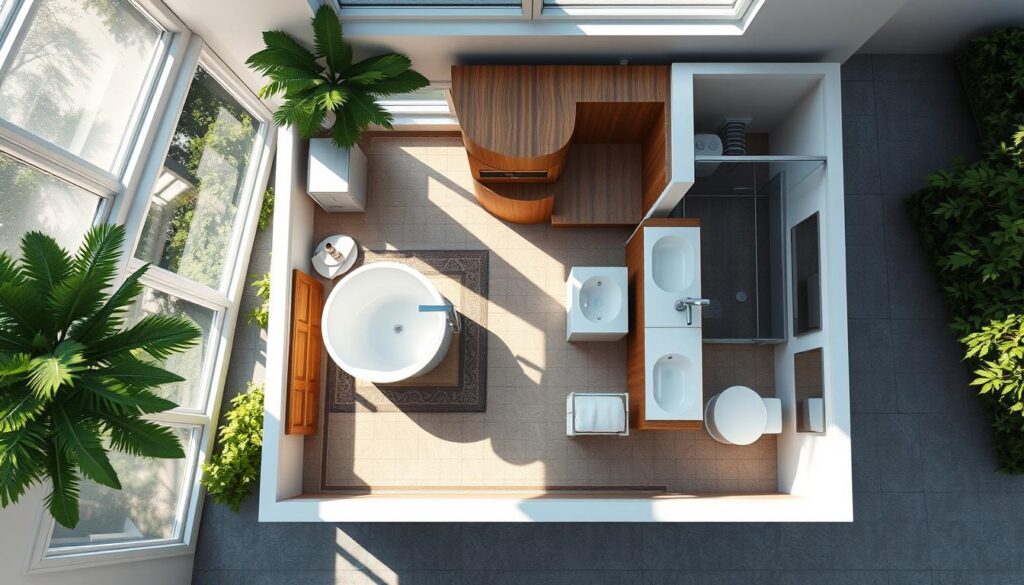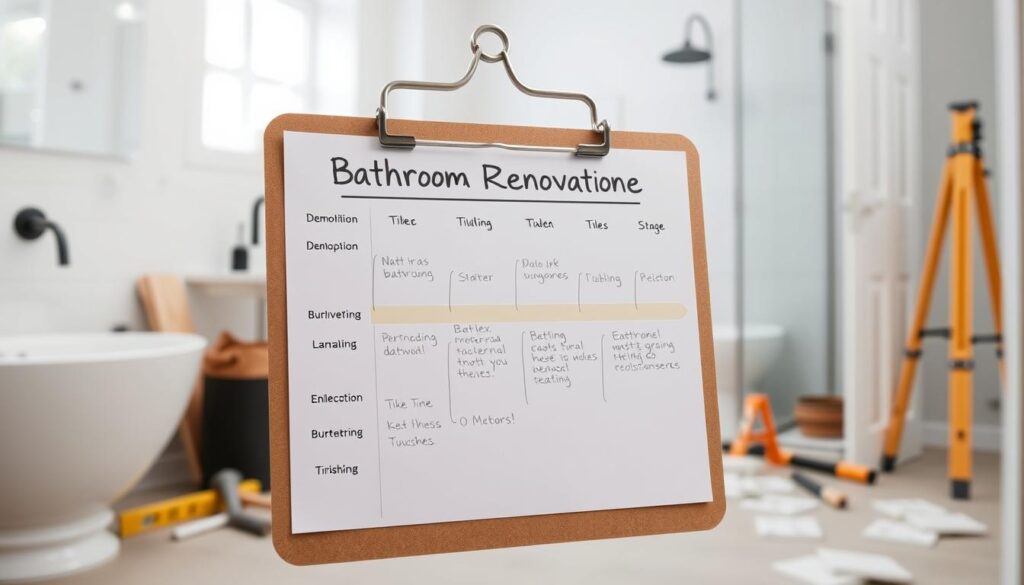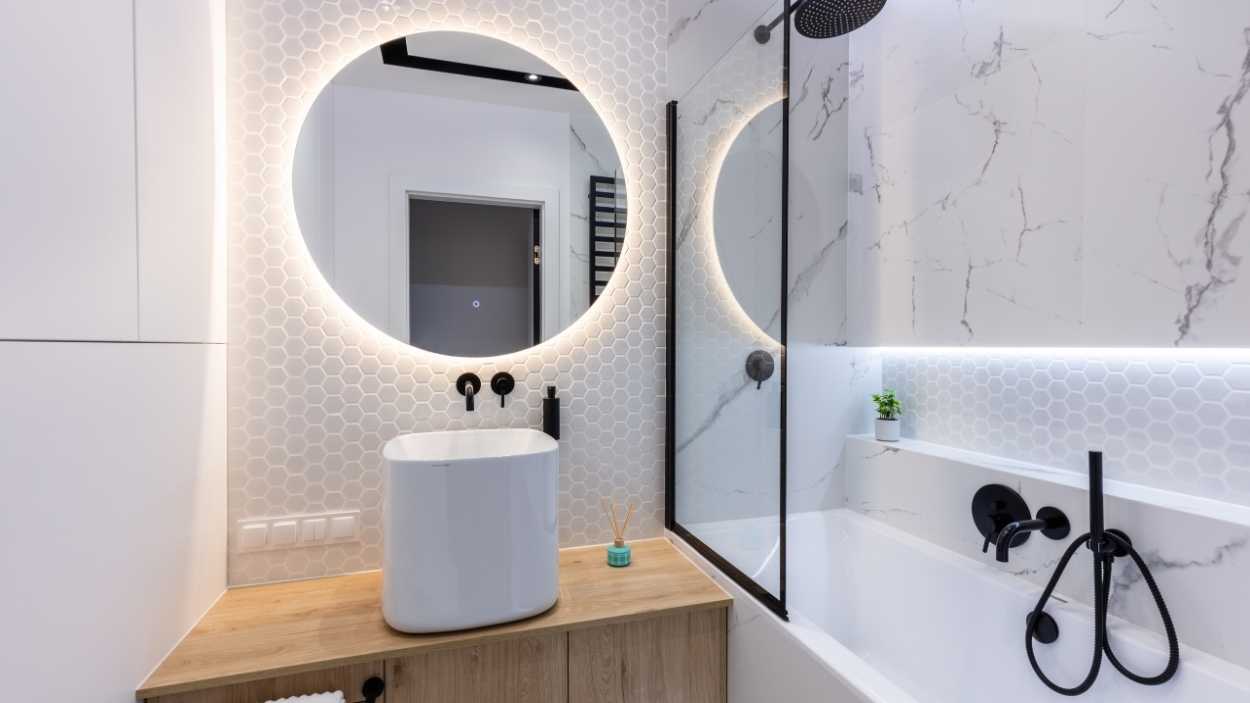Did you know that bathroom renovations can range in cost from $10,000 to $30,000 AUD, depending on the extent of the project? This staggering figure underscores the importance of careful planning and execution when it comes to transforming one of the most vital spaces in your home. The first and most crucial step in your bathroom renovation journey is to define your goals, needs, and vision for the space.
Proper planning lays the foundation for a successful bathroom renovation by identifying your desired features, layout, and overall aesthetic. This upfront investment of time and effort will help you make informed decisions, avoid costly mistakes, and ensure your renovation meets your functional and style preferences. Taking the time to carefully consider your objectives and requirements will set the stage for a smooth, efficient, and satisfying bathroom transformation.
Key Takeaways
- Defining your renovation goals, needs, and vision is the most important first step in a bathroom remodel.
- Careful planning helps you make informed decisions, avoid costly mistakes, and ensure the renovation meets your functional and style preferences.
- Proper planning lays the foundation for a successful bathroom renovation project.
- Taking the time upfront to consider your objectives and requirements will set the stage for a smooth, efficient, and satisfying transformation.
- Considering your desired bathroom features, layout, and overall aesthetic is crucial for a successful renovation.
Defining Your Bathroom Renovation Goals
Before embarking on your bathroom renovation, it’s crucial to clearly define your goals, needs, and vision for the space. Take the time to consider what you like and dislike about your current bathroom, and identify any functional or layout issues you want to address. This will ensure your renovation aligns with your lifestyle and aesthetic preferences.
Identifying Your Needs and Vision
Start by envisioning your ideal bathroom. What features do you desire, such as a separate shower, double vanity, or in-wall toilet cistern? Sketching out your preferred layout can help you visualize the changes you want to make and discuss feasibility with your contractor. Consider how you use the space and what improvements would enhance your daily routine.
Determining Your Desired Bathroom Features
- Identify must-have features, such as a modern shower design, ample storage, or a luxurious freestanding bathtub.
- Prioritize functionality over form, ensuring the layout and fixture selections cater to your practical needs.
- Explore innovative storage solutions, like custom vanities or recessed shelving, to optimize the available space.
By taking the time to define your goals and vision, you’ll be able to work with your contractor to create a bathroom design that truly reflects your personal style and enhances your daily life.
Establishing Your Bathroom Renovation Budget
Crafting a realistic budget is a vital step in your bathroom renovation journey. Start by researching current prices for materials, fixtures, and labor in your local market. Obtain multiple quotes from reputable tradespeople to gain an accurate understanding of the costs involved. For instance, the average cost for a Buildmat Carina Bumps Basin is $249, while an Ascari Brushed Brass Gold Hand Towel Rail costs $139 and an Ashanti Brushed Brass Gold Gooseneck Mixer is priced at $279.
Getting Current Quotes for Materials and Labor
As you gather quotes, be sure to account for unexpected expenses. During demolition, you may uncover damage or encounter plumbing and electrical issues that require additional work. A good rule of thumb is to allocate a 15% contingency budget to cover any unforeseen costs. This approach can help ensure your renovation stays on track and avoids costly overruns.
Accounting for Unexpected Expenses
For a typical bathroom renovation, the estimated cost range can vary from $5,000 to $10,000. However, in the 2018/2019 financial year, just over 233,000 Australian households chose to renovate their bathrooms, with an average cost of around $20,000. By carefully planning and budgeting, you can create the bathroom of your dreams without breaking the bank.
| Budget Category | Percentage of Total Cost |
|---|---|
| Plumbing | 10% |
| Electrical | 5% |
| Fixtures | 25% |
| Tiling/Waterproofing | 25% |
| Labor and Miscellaneous | 35% |
“Careful planning and design to avoid mid-project changes can help prevent disruptions, cost overruns, and delays during the renovation process.”
Planning Your Bathroom Layout
Careful planning of your bathroom space planning is essential to ensure the final design is both functional and aesthetically pleasing. Consider the placement of key fixture selection such as the toilet, vanity, and shower, to optimize the flow and usage of the space.
Decide whether you want a separate tub and shower or a combined unit, and think about the location of electrical outlets, lighting, and storage. Creating a detailed plan, potentially with the help of a designer or architect, will help you visualize the final result and identify any potential challenges before construction begins.
When planning your bathroom functional layout, be sure to take into account the size and shape of the room. If you have a smaller bathroom, consider wall-mounted fixtures and vanities to maximize the available floor space. Carefully measure the dimensions and identify any obstacles, such as windows or doors, that may impact the placement of your fixtures.
- Determine the ideal location for the toilet, vanity, and shower/tub to create a logical and efficient flow.
- Consider the placement of electrical outlets, lighting, and storage solutions to ensure they are accessible and integrated seamlessly into the design.
- Explore options for a separate tub and shower or a combined unit, based on your personal preferences and the available space.
- Utilize 3D computer modeling or work with a designer to visualize the final layout and identify any potential challenges before construction begins.
| Bathroom Item | Essential | Nice-to-Have |
|---|---|---|
| Toilet | ✓ | |
| Vanity | ✓ | |
| Shower | ✓ | |
| Bathtub | ✓ | |
| Bidet | ✓ | |
| Bathroom Furniture | ✓ |
Remember, even in a small bathroom, with careful space planning and smart design choices, you can create a functional and visually appealing space that meets all your needs.

Selecting Durable and Stylish Materials
Choosing the right materials and products for your bathroom renovation is crucial for both durability and aesthetic appeal. Select high-quality, water-resistant tiles, countertops, and fixtures that can withstand the demands of a bathroom environment. Consider the overall style you want to achieve, whether it’s a modern, minimalist look or a more traditional, spa-like atmosphere.
Choosing High-Quality Bathroom Products
Research reputable brands and work with knowledgeable sales associates to ensure you’re making informed choices that will stand the test of time. Investing in quality materials will pay off in the long run by providing a beautiful and long-lasting bathroom.
Considering Durability and Style
When it comes to product selection, focus on options that not only enhance the visual appeal of your bathroom but also offer exceptional durability and easy maintenance. This will ensure your renovation stands the test of time and continues to impress for years to come.
| Material | Durability | Style |
|---|---|---|
| Natural Stone Tiles | High | Elegant, Timeless |
| Ceramic Tiles | Moderate | Versatile, Contemporary |
| Engineered Stone Countertops | High | Sleek, Modern |
| Wood Vanities | High | Warm, Traditional |
Remember, investing in quality materials and products can make all the difference in the long-term durability and style of your bathroom renovation.
Hiring Experienced Tradespeople
When it comes to your bathroom renovation, assembling the right team of professional contractors is crucial for the project’s success. This typically includes a plumber, electrician, tiler, and potentially a general contractor to oversee the entire process. Take the time to thoroughly research and vet potential candidates, checking their credentials, licenses, and references.
Hiring a reputable and skilled team ensures the work is completed to a high standard, on time, and within your budget. These experienced tradespeople can also provide valuable insights and recommendations throughout the renovation, helping you make informed decisions that align with your vision and goals.
According to industry experts, bathrooms and kitchens significantly impact a home’s appeal and value. Therefore, it’s essential to prioritize hiring professional contractors who can deliver exceptional results. Online reviews can be a helpful resource when evaluating local contractors, as they offer insights into the quality of their work and customer satisfaction.
It’s recommended to interview at least three professionals for your bathroom renovation and request at least three referrals from their former customers. This will help you make an informed decision and ensure you’re partnering with the right team for your project timeline and budget.
Remember, the cost of materials and the contractors’ response time can also influence the renovation quote and the overall renovation process. By working with experienced tradespeople, you can rest assured that your bathroom renovation will be a seamless and successful endeavor.
In addition to the plumber and electrician, a general contractor can play a crucial role in managing the overall bathroom renovation project, particularly when it involves the coordination of various trades. Tilers, painters, and decorators are also essential contributors to the final outcome, ensuring the bathroom not only functions but also exudes style and elegance.
When it comes to bathroom renovations, proper waterproofing by specialists in wet areas like showers and bathtubs is vital to prevent moisture damage. Neglecting this aspect can lead to costly repairs down the line, so it’s crucial to work with professionals who prioritize this important step.
Creating a Renovation Schedule
Developing a comprehensive renovation schedule is essential for the smooth execution of your bathroom transformation. This involves meticulously coordinating the arrival of various tradespeople, such as plumbers, electricians, and tilers, to ensure their work is completed in the correct order. By creating a well-planned schedule, you can minimize delays, keep your project on track, and have a clear understanding of the timeline for your bathroom renovation.
Coordinating Tradesperson Arrivals
Effective tradesperson coordination is crucial for the success of your bathroom renovation. Provide ample notice to the professionals involved, as their schedules tend to be quite busy. Communicate with them regularly to ensure they arrive at the right time and complete their tasks efficiently. This will help maintain the project’s momentum and prevent any unnecessary downtime.
Allowing for Sufficient Time
When creating your renovation schedule, be sure to allot sufficient time for each task. Rushing can lead to mistakes or subpar workmanship, which can ultimately delay the overall project and increase costs. According to industry data, the average bathroom renovation in Australia takes around 4-6 weeks to complete, depending on the scope of the project. By factoring in realistic timelines, you can set realistic expectations and avoid unexpected delays.
| State | Average Bathroom Renovation Cost |
|---|---|
| Western Australia | $15,667 |
| South Australia | $14,375 |
| New South Wales | $22,392 |
| Victoria | $22,381 |
| Queensland | $20,382 |
| Tasmania | $21,667 |
By creating a well-planned renovation schedule and coordinating with tradespeople, you can ensure your bathroom transformation stays on track and within your budget. Remember to allow sufficient time for each task to avoid any costly delays or mistakes.

Demolition and Preparation
The remodeling process of your bathroom renovation journey begins with the critical stage of demolition and preparation. This phase sets the foundation for the entire project, as it involves carefully removing all existing fixtures, fittings, tiles, and other materials from the bathroom. Proper demolition and preparation are essential to uncover any underlying issues, such as water damage or structural problems, and to ensure a smooth transition to the installation of new plumbing, electrical, and other necessary components.
Before you commence the demolition, it’s crucial to have a well-thought-out plan in place. Approximately 60-70% of bathroom renovation time is spent on this phase, and survey results indicate that 85% of successful bathroom renovations begin with a proper demolition plan. Additionally, industry insights reveal that 50% of renovation delays are caused by inadequate planning and execution of the tearing out walls and flooring stage.
- Bathroom projects typically require a 10 to 15 per cent surplus in funds to cover unforeseen expenses.
- Many bathrooms lack proper waterproofing, resulting in floor damage over time.
- DIY bathroom demolition may save costs compared to hiring a professional.
- Demolition safety equipment includes safety glasses, gloves, ear muffs, and appropriate clothing.
- Tools required for bathroom demolition include angle grinder, impact driver, various saw types, utility knife, hammer types, tape measure, wheelbarrow, shovels, wrecking bars, drop sheets, and ladder.
It’s important to note that homes, particularly older ones, may have asbestos sheeting, requiring professional assessment during demolition. According to safety regulations, asbestos is present in approximately 5% of older homes’ bathroom materials. Proper handling and disposal of these hazardous materials are essential to ensure the safety of both the homeowners and the renovation team.
Once the bathroom is cleared, the space can be properly prepared for the installation of new plumbing, electrical, and other necessary components. This preparatory work is crucial for the success of your bathroom renovation project, laying the foundation for a transformed and functional space.
By approaching the demolition and preparation phase with a strategic mindset, you can set the stage for a seamless and successful bathroom remodeling process. Remember, the time and effort invested in this critical first step will pay dividends in the long run, ensuring a smooth and efficient renovation journey.
Installing New Plumbing and Electrical
After the demolition and preparation stage, the next crucial step in your bathroom renovation is to install the new plumbing and electrical systems. This may involve relocating fixtures, such as the toilet, vanity, or shower, and rerouting wiring and pipes to accommodate the desired layout. It’s also essential to carefully inspect any existing plumbing and electrical setups to ensure they are in good working order and to identify and address any potential issues before the new components are installed.
Relocating Fixtures and Wiring
Relocating fixtures and wiring during a bathroom renovation is a common task. This may include moving the toilet, vanity, or shower to a new location to achieve the desired layout. Proper planning and execution are crucial to ensure the new placement of these fixtures is both functional and aesthetically pleasing. Similarly, rerouting electrical wiring to accommodate the new layout is an important consideration, as it ensures the safety and efficiency of the renovated space.
Inspecting Existing Setups
Before installing the new plumbing and electrical systems, it’s vital to inspect any existing setups thoroughly. This includes checking the condition of the current wiring, pipes, and fixtures to identify any potential problems or safety concerns. By addressing these issues before the renovation, you can prevent costly and time-consuming repairs down the line, ensuring a seamless and successful bathroom transformation.
Proper installation of the plumbing and electrical systems is crucial for the overall functionality and safety of the renovated bathroom. By carefully planning and executing these critical tasks, you can ensure your new bathroom not only looks stunning but also operates efficiently and safely for years to come.
“Attention to detail in the plumbing and electrical work is essential for a successful bathroom renovation. Cutting corners can lead to costly issues down the line, so it’s worth taking the time to get it right.”
Repairing Damage and Replacing Walls
As the new plumbing and electrical work is completed, the next crucial step in your bathroom renovation process is to address any damage that has been uncovered during the demolition stage. This may involve fixing holes, replacing water-damaged drywall, or even re-framing walls. Using the appropriate moisture-resistant materials, such as specialized bathroom drywall, is essential to ensure the long-term integrity and functionality of the renovated space.
Tackling these repair and replacement tasks early on is crucial for preventing future issues and achieving a seamless, high-quality finish to your bathroom transformation. By proactively addressing any structural or aesthetic concerns, you can set the foundation for a successful and durable renovation.
- Identify and repair any holes or cracks in the walls, floors, or ceilings.
- Replace any water-damaged drywall or framing to ensure a solid, stable foundation.
- Use moisture-resistant materials, such as specialized bathroom drywall, to enhance the longevity of the renovated space.
- Ensure that all repair work is completed to a high standard, providing a clean canvas for the next stages of the renovation process.
Addressing damage repair and wall replacement early in the renovation process is an essential step in transforming your bathroom into a beautiful, functional, and durable space that will stand the test of time.
“Proper preparation and attention to detail during the repair and replacement stage can make all the difference in the final outcome of your bathroom renovation.”
Conclusion
Completing a successful bathroom renovation in Australia requires careful planning, attention to detail, and the right team of experienced professionals. By defining your bathroom design goals, establishing a realistic remodeling process budget, planning the layout, selecting quality materials, and managing the construction process, you can transform your bathroom into a stylish, functional, and durable space that meets your needs and vision.
Remember to allow sufficient time, coordinate with tradespeople, and address any issues that arise during the successful renovation. With thoughtful planning and execution, you can create the bathroom of your dreams and enjoy the benefits for years to come. By focusing on the critical steps outlined in this article, you can ensure your bathroom renovation project is a resounding success.
A well-designed and executed bathroom renovation not only enhances the functionality and aesthetic appeal of your home but can also increase its overall value. By investing in quality materials, hiring experienced professionals, and carefully managing the renovation process, you can create a bathroom that truly reflects your personal style and meets your family’s needs.



